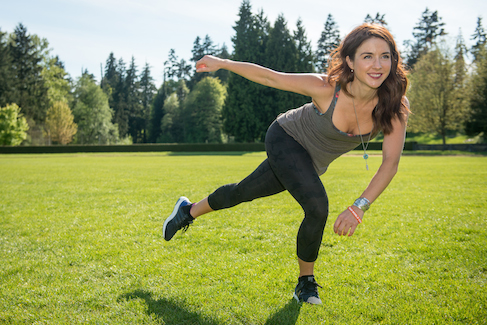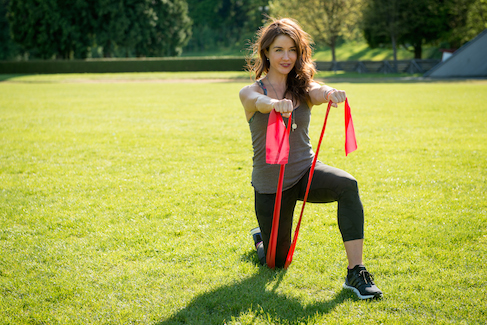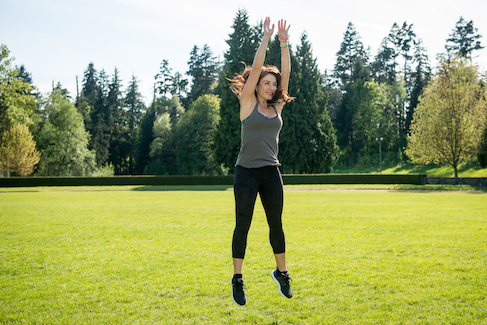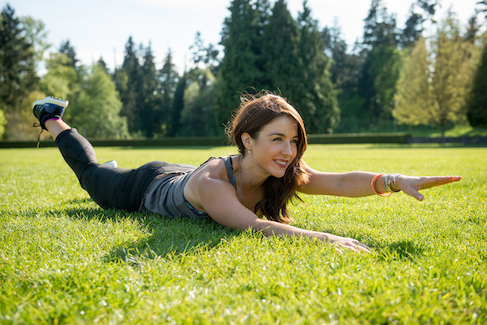On July 10, the Pan Am and Parapan Am Games kick off in Toronto, taking the sporting world to the world at large. As a runner, what’s it to you? A chance to open up your repertoire to all new cross-training ideas! We asked Erin Karpluk, formerly of Being Erica and now acting in Rookie Blue, to turn eight great sporting events into exercises for runners. Step up your race game while watching the best athletes in the world!
By Anna Lee Boschetto
Erin Karpluk is all in. When the actress, best known for her starring role on Being Erica, was approached by World Vision (an international advocacy organization working with children living in poverty-stricken communities) to run a portion of the BMO Vancouver Marathon in support of the charity, she knew she’d run the entire distance. “Running a marathon was one thing I wanted to check off my bucket list, so naturally I wanted to run the whole thing,” she explains.
Combining her experience with triathlon training, Karpluk realized she needed a solid training plan to get her across the finish line. So she looped back to her triathlon trainer, an old friend Paul Regensburg, who has also trained Canadian Olympian Simon Whitfield. As much as Karpluk focuses on her training efforts, she’s just as passionate about teaming up with World Vision.
What’s the best part of charity running? “When you can’t be there and help directly, it’s nice to know that in some way I’m raising awareness, helping people and putting out good vibes.”
With her work on Rookie Blue, a show Karpluk joined last season, keeping her busy, she doesn’t have her next race date set. In the mean time, Karpluk lent her athletic ability in demonstrating the training exercises based on the sports of the Pan Am Games.
Exercise program written by physiotherapist Lindsay Scott, follower her on Twitter @LindsayScottPT.
ROLLER—SPEED SKATING
Similar to a speed skater gliding on one leg, runners must be strongest when we’re on one foot. This is designed to strengthen your gluts, quads and balance as you power through a plane of motion that’s often weak in runners. Exercise: Do a lateral jump and reach your opposite hand to the outside of your planted foot. Complete 2-3 sets of 12 reps.
CYCLING
Cyclists depend on a strong, stable core to develop power through their legs. This exercise is designed to train you to effectively use your core, allowing you to become faster, have greater resistance, and avoid injury by improving your stability and generate power in your legs. Exercise: Lie on your back and draw your bellybutton to activate your deep core muscles. Bring one leg at a time into a “table top” position with your hip and knee bent to 90 degrees and your shins parallel to the floor. Place a hand on each leg, just above your knee. Apply slight pressure into your leg, while resisting any movement with your leg. Slowly extend one leg at a time, while maintaining slight pressure on your opposite leg. Return to the start position and repeat on the opposite leg. Complete 2-3 sets of 15 reps on each leg.
CANOE/KAYAK SLALOM
Canoeists must fight against rushing water to maintain a stable position in the boat. Runners can take a cue from these paddlers and maximize their efficiency by strengthening their core to fight rotational forces. By resisting the twisting motion of the band, you build strength in your core, and especially in the obliques. Exercise: Kneel on one knee with the resistance band anchored beside you with moderate tension. Maintain a strong core and neutral spine as you push both arms straight out in front of you, resisting the rotational force of the band. Complete 2 to 3 reps on each side.
RUGBY SEVENS
When a rugby ball goes out of bounds, teams line up and “boost” a teammate into the air to reach for the ball being thrown in. Practising this quick, explosive jump increases your ability to recruit more muscle fibres, which allows you to use oxygen more efficiently to fuel your muscles. Exercise: Lower down into a squat position, keeping your back straight. Jump up quickly. Focus on landing softly and avoid letting your knees collapse together. Complete 2 to 3 sets of 12 reps.
SWIMMING
For swimmers and runners, the muscles that make up the core work collectively to stabilize the trunk and provide added strength and efficiency to your arms and legs. This exercise is designed to train the core muscles in your lower back which are called into action as you pick up your pace. Exercise: Lie face down. Lift one arm and the opposite leg. Hold 3 seconds. Relax. Repeat on opposite side. Repeat 2-3 sets of 12 reps on each side.
SQUASH
There are three planes of motion in which the human body can move: the sagittal plane (forward and back), the frontal plane (side to side) and the transverse plane (rotation, like a golf swing). Squash players, who spend most of each match fighting for position, are strong in all planes of motion. Runners, on the other hand, are not. This will strengthen the lower body in all planes of motion. Exercise:
1. Lead with your left leg as you do 5 lunges forwards, to the side, at a 45 degree angle half way between the side and straight back, then straight back. 2. Repeat 5 times in each of the four directions on the opposite side, leading with your right foot
GYMNASTICS
Have you ever looked at a gymnast and marveled at their arm strength? The upper body is often overlooked by runners, but it can make a huge difference to your performance. With every foot strike, your arms drive your body forward, saving energy for your legs and helping you to maintain proper cadence and rhythm. Exercise: From an elevated plank (arms straight with your hands on the floor directly beneath your shoulders), bend your left elbow, lowering down so your left forearm is on the floor. Do the same on your right so you’re now supported by both forearms. Straighten your left arm, then your right, moving back to an elevated plank position. That’s one rep. Complete 2-3 reps of 12 on each side.
BOWLING
Similar to bowlers who must maintain a strong single leg stance in a dynamic environment as they release the ball, runners maintain a stable position as they repeatedly move from one leg to the next. One of the most common underlying causes of knee injuries is weakness in the muscles that stabilize the hips. A strengthening program focused on the hip leads to reduced variability in knee mechanics – or less “wobble” at the knee. Exercise: In a single-leg stance, squat down and reach hands to three targets: 45-degree angle left, straight ahead, 45-degree angle right. Stand all the way up between each position. Complete 2-3 reps of 12 on each side.














 Our Magazine
Our Magazine
